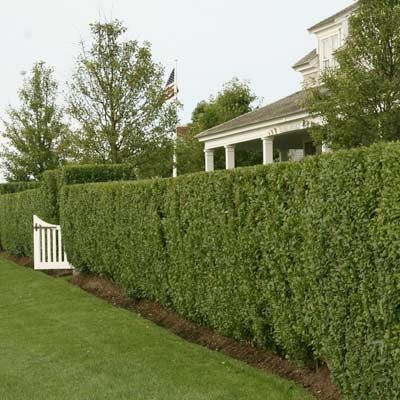
A formal hedge says “privacy, please” in a much more elegant way than a standard fence which is why privet hedges have long been a staple of suburban landscapes. But they’re not for everyone as privet hedges thrive in temperate climates and require regular maintenance to maintain their pristine appearance. If you decide that a hedge is just what your yard needs. this guide will explore the benefits of privet hedges, proper planting techniques, and essential care tips to help you create a stunning living wall in your garden.
Privet Hedge Planting Distance
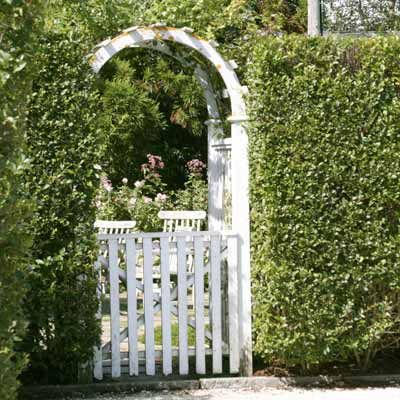
Proper planting is crucial for establishing a healthy and robust privet hedge. To ensure optimal growth and density, follow these guidelines when planting your privet hedge:
- Create a trench that is two feet wide and two feet deep.
- Space individual shrubs approximately 12 inches apart.
- Bring soil up to the branching trunk of each plant.
- Water deeply and frequently during the first year, preferably using drip irrigation.
This planting method provides ample room for root development and encourages the hedge to fill in quickly. During the initial stages, monitor soil moisture and adjust irrigation as needed. Remember that privet hedges prefer full sun exposure for best results. Planting in a location that gets at least six hours of direct sunlight daily ensures a lush hedge.
How To Make a Privet Hedge Thicker
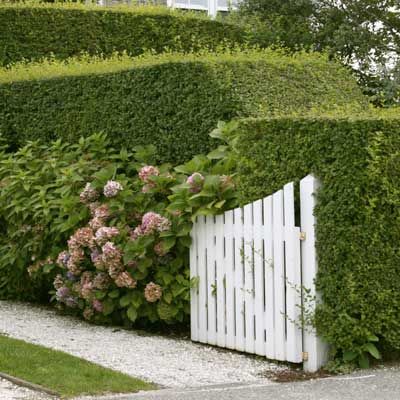
For those seeking an even more private hedge, consider planting a double row of privet shrubs. This involves creating a wider trench and arranging the plants in a zigzag pattern. The result is a multi-tiered hedge that provides enhanced privacy and a more dramatic backdrop for your garden.
To achieve this effect, dig a trench that is twice as wide as for a single row. Plant the shrubs in a staggered formation, alternating between the front and back of the trench. Maintain the same 12-inch spacing between plants within each row. Ensure proper watering and care for both rows of plants.
Additionally, mulching the base of the hedge helps retain soil moisture and prevents weed growth. This double-row planting method not only creates a thicker hedge but also adds depth and interest to your landscape. As shown in the image, a multi-tiered privet hedge can serve as a stunning backdrop for other plantings, such as hydrangeas or other flowering shrubs. The overlapping layers provide a sense of depth and richness, elevating the overall design of your garden.
Trimming a Privet Hedge
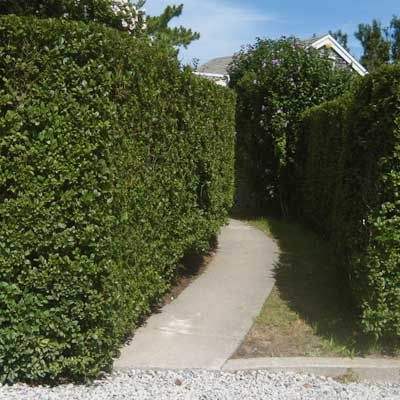
Regular trimming maintains the neat appearance and controlled growth of your privet hedge. Privet grows quickly and can become overgrown and look unkempt if left unchecked. To keep your hedge looking its best:
- Shear the hedge two to four times per season, depending on growth rate.
- Remove approximately 6 inches of growth for every foot of new growth.
- Trim more frequently during peak growing seasons (spring and early summer).
- Remove white flowers before they go to seed to prevent the plant from becoming invasive.
Proper trimming not only maintains the hedge’s shape but also prevents it from encroaching on nearby paths or structures. Pay attention to the base of the hedge during trimming to ensure sunlight reaches the lower leaves, promoting uniform growth. A well-maintained privet hedge can soften the look of hardscaping elements, such as concrete paths, while providing a clean, defined edge to your landscape. Regular monitoring and prompt removal of any dead or diseased branches also contribute to a healthy and visually appealing hedge.
Privet Hedge Maintenance
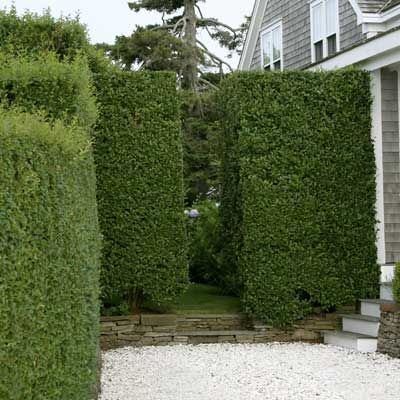
Follow these tips for optimal hedge care:
- Shape the hedge narrower at the top and wider at the bottom to allow sunlight to reach lower leaves.
- Prune regularly to maintain density and prevent bare patches.
- Water deeply during dry periods, especially for newly established hedges.
- Apply a balanced, slow-release fertilizer in early spring to promote healthy growth.
- Monitor for pests and diseases, treating promptly if issues arise.
Additionally, adding organic compost to the soil can enhance nutrient availability and improve overall plant health. Regular mulching and maintaining proper soil pH levels contribute to the overall resilience and growth rate of the hedge.
Hedge Arches
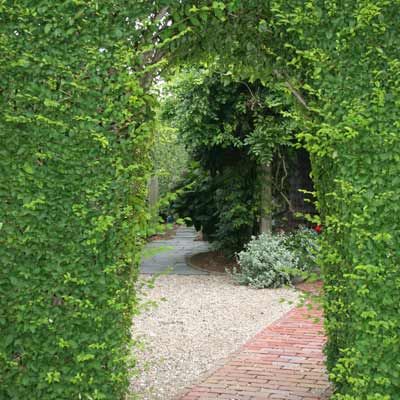
Privet hedges can be trained to form elegant arches. In this pleached arch, two plants meet at the top to accentuate a path, creating a stunning focal point.
To create a privet arch, plant two privet shrubs on either side of the desired archway. As the plants grow, gently bend and tie the branches to a supportive structure. Continue training the plants until they meet at the top, forming a complete arch. Regularly trim and shape the arch to maintain its form.
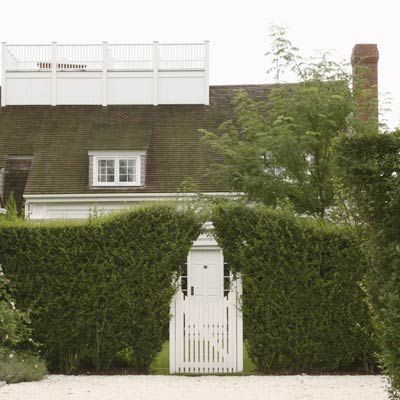
This technique requires patience and consistent care but results in a unique and eye-catching garden feature. Regularly inspecting the supportive structure, such as a trellis or metal frame, ensures that it remains sturdy and aligns with the natural growth of your privet. Adding decorative elements such as fairy lights or seasonal flowers can enhance the look of your privet arch.

Hedge with a view: Use a natural arch to frame a tranquil view in your garden. This technique draws the eye to a specific focal point, whether it’s a beautiful landscape or a garden feature, adding to the design of your outdoor space. The framed view becomes an integral part of your garden’s layout, guiding attention and creating a harmonious connection between different areas of your landscape.

Privet Hedge Varieties
While Ligustrum ovalifolium and L. amurense are popular hedge choices, there are several other privet varieties to consider for your hedge, including the following:
- Common Privet (Ligustrum vulgare): A hardy variety that tolerates poor soil and partial shade.
- Golden privet (Ligustrum ovalifolium ‘Aureum’): Features bright yellow-green foliage for added color
- Japanese privet (Ligustrum japonicum): An evergreen variety with larger, glossy leaves
- Wax-Leaf privet (Ligustrum lucidum): Another evergreen option with a more tree-like growth habit
Consider the specific needs of each variety, such as soil type, water requirements, and growth patterns, to find the best fit for your garden. Choose the variety that best suits your climate, soil conditions, and aesthetic preferences. Consulting with a local nursery or horticulture expert can provide additional insights into the ideal variety for your specific location and gardening goals.
Environmental Considerations for Privet Hedge
While privet hedges offer many benefits, it’s important to be aware of these potential environmental concerns:
- Invasiveness: Some privet species can become invasive if not properly managed. Always remove flowers before they set seed.
- Wildlife impact: Dense privet hedges can provide shelter for birds and small animals but may also displace native plant species.
- Allergies: Privet flowers can trigger allergies in some individuals. Consider this if you or your family members are sensitive to pollen.
Taking proactive measures such as regular monitoring and responsible pruning helps mitigate these concerns. Researching local regulations regarding invasive species and adhering to best practices for pruning and plant care ensures that your privet hedge adds ecological value to your garden.
